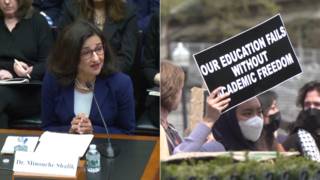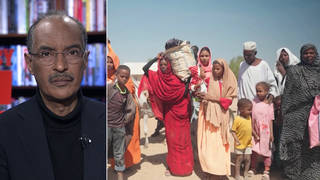
Related
Guests
- James Petrasauthor and journalist, Professor Emeritus at SUNY Binghamton. He has written about Latin America for many years and is author of the book, “Social Movements and State Power: Argentina, Brazil, Bolivia, Ecuador.”
Jyllands-Posten, the Danish newspaper at the heart of the cartoon controversy, has staunchly defended its decision to run the images, which included depictions of the prophet Mohammed with a bomb. On Monday, the Guardian of London revealed the newspaper refused to run drawings lampooning Jesus Christ. We take a look at Jyllands-Posten with Brandeis University professor Jytte Klausen. [include rush transcript]
Muslims are continuing to stage protests around the world following the publication of cartoons of the Prophet Mohammed. _> Earlier today about half a million Muslims in Lebanon peacefully protest against the cartoons. In Afghanistan, police shot four protesters dead on Wednesday bringing the death toll to 10 over the past three days. In the West Bank, demonstrators stormed the headquarters of international observers stationed in Hebron. Over the past week, protests have broken out in dozens of cities across Europe, the Middle East and parts of Asia.
In Washington Secretary of State Condoleezza Rice accused Syria and Iran of using the controversy to incite anti-West sentiment.
- Condoleezza Rice, Secretary of State, February 8th, 2006.
On Wednesday President Bush discussed the situation publicly for the first time during a public appearance with Jordan’s King Abdullah.
- President Bush, speaking February 8th, 2006.
Meanwhile the New York Times is reporting the outrage over the cartoons largely grew out of a meeting of the Organization of the Islamic Conference held in Mecca in Saudi Arabia in December–three months after the cartoons first appeared in a Danish newspaper. Attending the summit were the leaders of the world’s 57 Muslim nations.
The leaders issued a closing communique that expressed “concern at rising hatred against Islam and Muslims and condemned the recent incident of desecration of the image of the Holy Prophet Muhammad in the media of certain countries.”
In Britain Muslim leaders gathered on Wednesday to discuss their response to the printing of the cartoons.
Sheikh Fiaz Siffiqi of the Muslim Action Committee compared the publication of the cartoons to Salman Rushdie’s novel The Satanic Verses which was banned by several Muslim nations for its depiction of the Prophet Muhammad.
- Sheikh Fiaz Siffiqi, Muslim Action Committee.
On Monday, the Guardian of London revealed that the Danish newspaper that first published the cartoons refused to run drawings lampooning Jesus Christ. In April 2003, a Danish illustrator submitted a series of cartoons dealing with the resurrection of Christ. He received an email back from the paper’s editor which said: “I don’t think our readers will enjoy the drawings. As a matter of fact, I think that they will provoke an outcry. Therefore, I will not use them.”
- Jytte Klausen, Associate Professor of Comparative Politics at Brandeis University. Her most recent book is “The Islamic Challenge: Politics and Religion in Western Europe.”
Transcript
JUAN GONZALEZ: In Washington Secretary of State Condoleezza Rice accused Syria and Iran of using the controversy to incite anti-West sentiment.
CONDOLEEZZA RICE: There are governments that have also used this opportunity to incite violence. I don’t have any doubt that given the control of the Syrian government in Syria, given the control of the Iranian government which by the way, hasn’t even hidden its hand in this, that Iran and Syria have gone out of its way to inflame sentiments and to use this to their own purposes and the world ought to call them on it.
AMY GOODMAN: And on Wednesday President Bush discussed the situation publicly for the first time during a public appearance with Jordan’s King Abdullah.
GEORGE W. BUSH: We believe in a free press. We also recognize that with freedom comes responsibilities. With freedom comes the responsibility to be thoughtful about others. Finally, I have made it clear to His Majesty and he made it clear to me that we reject violence as a way to express discontent with what may be printed in a free press.
JUAN GONZALEZ: Sheikh Fiaz Siffiqi of the Muslim Action Committee compared the publication of the cartoons to Salman Rushdie’s novel The Satanic Verses which was banned by several Muslim nations for its depiction of the Prophet Muhammad.
SHEIKH FIAZ SIFFIQI: It has to be said that there has been reports of a very deep offense that has been caused to the Muslim community and there’s been reports of deep anger and deep frustration that once again we have not learned the lessons of 16, 17 years ago when the Prophet Muhammad peace be upon him was insulted by Salman Rushdie. Now here we are again, back to square one again insulting the Prophet Muhammad.
AMY GOODMAN: Just before the program we spoke to Jytte Klausen, an Associate Professor of Comparative Politics at Brandeis University. Her most recent book is “The Islamic Challenge: Politics and Religion in Western Europe.” We reached her in Brussels and I asked her to talk about the Danish newspaper that published the cartoons.
JYTTE KLAUSEN: Yes, the paper is the country’s largest newspaper which means it has a circulation of about 175,000 copies. It is a conservative paper. It has a long tradition for association with the party of Anders Fogh Rasmussen, the Prime Minister of Denmark today. It has always taken into consideration the religious sensitivities of its readers who are primarily provincial middle class and farmers.
AMY GOODMAN: And can you then talk about their decision to do this and what it meant in Denmark?
JYTTE KLAUSEN: Well, there are different stories. One story is, what they say, Flemming Rose, the editor of the paper who was responsible for the cartoons said that he was dissatisfied with the spreading of self censorship in Denmark on all matters related to Islam. And as examples he gave that there were two theatre performances which were critical and funny reviews, over the summertime that had stories about George Bush but none of them had any stories about Osama Bin Laden. You can ask how funny it is to make a story about Osama Bin Laden, but that was one of his examples of censorship.
Another was that a children’s book author said that he couldn’t find anybody to make illustrations for a book about the Prophet. However that book is now out and it does have an illustration of the Prophet on the front page of the Prophet sitting on a winged horse. The book is selling quite well and no Muslims have protested it because the drawing is quite mushy and nice. It is not a political caricature.
AMY GOODMAN: Yet, the cartoon of Christ was turned down because it would not be appealing, the editor said.
JYTTE KLAUSEN: Yes, and the cartoons about— the paper published twelve cartoons. They were the result of what the editor called a competition. He said he wanted all Danish— he invited all Danish cartoonists to think about how they would portray the Prophet Muhammad, and only twelve came back and he published those twelve.
Some of them are noxious and a few of them even can make you laugh. But some of them portray the Prophet with a big bulbous nose, and a blood-dripping sword, with a halo that’s broken into little horns. They really stereotype Muslims as bloodthirsty sex maniacs.
AMY GOODMAN: Can you put the newspaper in the context of the politics of Denmark and also the politics of immigration, how immigrants are dealt with, particularly Muslim immigrants and Arab immigrants into Denmark right now?
JYTTE KLAUSEN: I think the best way of doing that is to describe what happened just a week before the cartoons were published. There was an annual meeting of one of the parties, it’s a coalitional government, Denmark has many parties and no one party has enough votes to govern. So the government is a coalition of two parties, two right-wing parties, and they depend on the very xenophobic Danish People’s Party for the majority.
At the annual meeting, one of the parties before the courtroom, Brian Mikkelsen said that in the past five years, he said, Denmark has been in a cultural war and the government has now won the first round and this is a time to start the second round to eliminate all signs of multiculturalist relativism in Denmark. It was a battle cry. The government has been deeply engaged in a project of Danish moral restoration. The definition of — shop definition of Danish values, which they say are Christian values. And the Danish People’s Party, members of the Danish People’s Party, two of them are in fact pastors in the Lutheran church, have repeatedly stood up in parliament and said that Muslims are a cancer on Danish society.
AMY GOODMAN: So how do you think this decision to run these cartoons fits into that?
JYTTE KLAUSEN: It’s a political decision. They are political pals. They — it was a short-sided decision. It was also an attempt to, you know, fill time when the news is slow. I think that Flemming Rose, the editor had no idea what would actually happen. He had a good idea that he would offend Muslims, but he thought this was just a matter of domestic politics and he didn’t really understand why these cartoons were so offensive to Muslims. He certainly had no clue that they would lead to a cartoon war in Iran, which is what has happened now. By the way, he has offered a helping hand to Iran in drawing cartoons depicting the Holocaust.
AMY GOODMAN: What do you mean, Iran put out in their national newspaper anyone who could come up with a cartoon of the Holocaust, they’d have a competition, and what is he doing in Denmark?
JYTTE KLAUSEN: Well, he publicly announced that the paper, the paper, the Danish paper, Jyllands-Posten will work together in assistance with the Iranians who want to draw the Holocaust and that the paper would publish and print the Holocaust cartoons. It is a stunning decision and one can only think that these people are completely out of their minds. But when I discussed — I teach at a Jewish university, and when I discuss the cartoons with my students, their immediate reaction was, if they can draw this kind of cartoon about Muslims, what is it to prevent them from doing it about Jews. And obviously my students were on to something.
AMY GOODMAN: Jytte Klausen, Associate Professor of Comparative Politics at Brandeis University speaking to us from Brussels.












Media Options